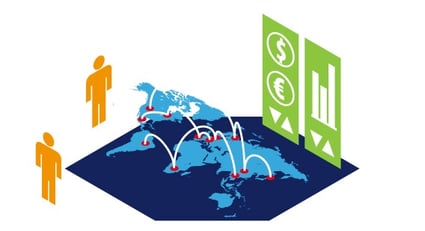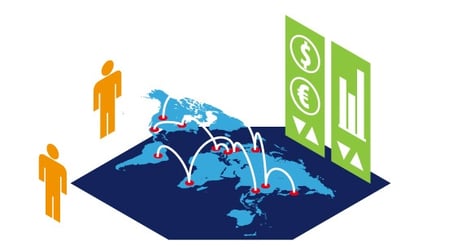How Strategic Network Planning Can Combat Risk
Brian Hoey - May 01, 2018

 Let’s say you’re tasked with designing a factory. You need to decide how to integrate various production lines, where to locate specific resources, how to organize space in a way that maximizes efficiency within and between processes, and how to leave room for potential future process changes. The interplay of a complex series of elements and structures will ultimately determine the success or failure of many planned production programs, so your grasp of the interrelations between these elements must be excellent. Once the factory has been established, things become even trickier. If you want to reposition a piece of machinery, for instance, you should know in great detail what processes involve that machine and how those processes will be affected. In short, these are tasks that you wouldn’t undertake without a carefully devised strategic plans that accounts for a variety of modalities.
Let’s say you’re tasked with designing a factory. You need to decide how to integrate various production lines, where to locate specific resources, how to organize space in a way that maximizes efficiency within and between processes, and how to leave room for potential future process changes. The interplay of a complex series of elements and structures will ultimately determine the success or failure of many planned production programs, so your grasp of the interrelations between these elements must be excellent. Once the factory has been established, things become even trickier. If you want to reposition a piece of machinery, for instance, you should know in great detail what processes involve that machine and how those processes will be affected. In short, these are tasks that you wouldn’t undertake without a carefully devised strategic plans that accounts for a variety of modalities.
Now, let’s say that your factory is not in a centralized location, but dispersed across a wide geographic landscape. Instead of machines and factory lines, your systems deal with hubs, transit centers, fleets of vehicles, and complex sets of restrictions. Though the components are different, the idea is the same—but on a much larger scale: interlocking elements create a complex, often temperamental network of interconnected workflows. The challenge, when attempting to make adjustments to such a complex network, is predicting which changes will result in what effects. Because the scope is so much wider the inherent risks are that much greater. Traffic, weather, and other supply chain events conspire to disrupt the plans of freight forwarders and supply chain logistics experts around the globe. One of the industry’s most important challenges is to mitigate those risks. Strategic network planning is a method of doing just that.
Strategic Network Planning
In our factory example, strategic network planning might be the equivalent of intelligent production planning, i.e. a framework in which all relevant modalities are accounted for and can be adjusted as necessary. By mapping out a schematic that includes all volumes, customer information, delivery/pickup restrictions, and hub constraints that affect your freight and hub network, strategic network planning enables you to visualize and share KPIs pertaining to various operational shifts or adjustments that you might make.
Without a clear understanding of your network design, it can be difficult to predict the impact of losing or gaining a customer, adjusting a highly-trafficked transport route, changing hub or fulfillment locations, or any other operational change in your value stream. The result is a supply chain that is especially susceptible to risk, owing to the difficulty of making informed adjustments and administrating your network in an agile, adaptable way.
Letting Go of the Past
Simply put, a strategic network plan helps freight forwarders and shippers to escape the cycle of using incomplete, past-oriented information when it comes to making key decisions about network usage. By transitioning away from a past-oriented mindset to a future-focused approach, businesses can begin to better foresee the bottlenecks and breakdowns that will arise as they utilize their value chains.
In this way, freight forwarders can begin to gain answers to important operational questions, such as:
- What are the costs of taking a new customer into my network? What happens if I win (or lose) that customer?
- How will may network adjust to freight cost increases, either overall or with regard to particular areas or vehicle types?
- What are the potential effects of any special promotions?
- How will changing lead times impact my organization? What are the cost implications, which customers are affected, and how will it change my main haul network?
- What are the effects of opening or closing a hub? A new X-dock between hubs?
In doing so, businesses can gain a more holistic view of their value streams, in which future changes have predictable effects and the overall level of risk is mitigated by an ever-more-adaptable network.
What If?
Once your network is mapped out in a way that decreases your reliance on past data, the next step in combatting supply chain risk is to leverage your strategic network planning infrastructure into predictive “what if?” simulations and “sandbox” scenarios that enable you to model potential future changes in a visible, flexible framework. These simulations can be shared intra-operationally in a way that promotes collaboration and decreases planning silos. If we define risk as the intrusion of the unforeseen, then any workflow adjustment that increases visibility and ensures that key stakeholders are in possession of all mission critical information necessarily decreases risk. More than that, running hypothetical simulations further orients your planning processes toward the future, helping your value stream to adapt to changing circumstances in a dynamic way. The result is added value via scenario-based planning that turns past issues into future successes.
LATEST POSTS
- Understand Circular Economy in The Manufacturing Industry
- How Can Industry 4.0 IT Integration Be Achieved Smoothly?
- The Significance of Order Sequencing in Discrete Manufacturing
- How to improve your Supply Chain Management: The Power of Control Towers
- Optimizing Human Resource Scheduling in Manufacturing: A Technological Approach



